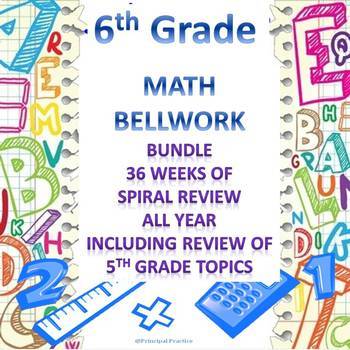6th Grade Math Bellwork 36 Week Bundle
Principal Practice
876 Followers
Grade Levels
6th
Subjects
Resource Type
Standards
CCSS6.G.A.1
CCSS6.G.A.2
CCSS6.G.A.3
CCSS6.G.A.4
CCSS6.SP.A.1
Formats Included
- Zip
Pages
108 pages
Principal Practice
876 Followers
Products in this Bundle (6)
showing 1-5 of 6 products
Description
This Product Includes:
- 6th Grade Math Bellwork for the entire year!
- Includes 4 weeks of 5th grade review then continuous spiral reviewing of
6th grade skills including ratio and proportion, number systems, statistics and
probability, equations and expressions, and geometry. All questions
are set up in a test-like format with multiple choice, multiple select, and
computational practice.
- Short problem sets for each Monday – Thursday which can be
printed front and back; Each Friday is a full page set with
questions like Monday – Thursday which could be used as a quiz
or Thursday night homework. There is also a link for access to
make a copy of a self-grading Google Forms Assessment version
of the Friday quiz for each week.
- This bellwork is set up similar to the Spiral Reviews which
are for test prep the weeks prior to required assessments.
Purchase an entire year of bellwork now at a reduced price!
*****************************************************************************
Customer Tips:
How to get TPT credit to use on future purchases:
• Please go to your My Purchases page (you may need to
login). Beside each purchase you'll see a Provide Feedback button.
Simply click it and you will be taken to a page where you can give a quick rating and
leave a short comment for the product. Each time you give feedback, TPT gives you
feedback credits that you use to lower the cost of your future purchases. I value your
feedback greatly as it helps me determine which products are most valuable for your
classroom so I can create more for you. ☺
Be the first to know about my new discounts, freebies and product launches:
• Look for the green star next to my store logo and
click it to become a follower. You will now receive email updates
about Principal Practice. ☺
*****************************************************************************
- 6th Grade Math Bellwork for the entire year!
- Includes 4 weeks of 5th grade review then continuous spiral reviewing of
6th grade skills including ratio and proportion, number systems, statistics and
probability, equations and expressions, and geometry. All questions
are set up in a test-like format with multiple choice, multiple select, and
computational practice.
- Short problem sets for each Monday – Thursday which can be
printed front and back; Each Friday is a full page set with
questions like Monday – Thursday which could be used as a quiz
or Thursday night homework. There is also a link for access to
make a copy of a self-grading Google Forms Assessment version
of the Friday quiz for each week.
- This bellwork is set up similar to the Spiral Reviews which
are for test prep the weeks prior to required assessments.
Purchase an entire year of bellwork now at a reduced price!
*****************************************************************************
Customer Tips:
How to get TPT credit to use on future purchases:
• Please go to your My Purchases page (you may need to
login). Beside each purchase you'll see a Provide Feedback button.
Simply click it and you will be taken to a page where you can give a quick rating and
leave a short comment for the product. Each time you give feedback, TPT gives you
feedback credits that you use to lower the cost of your future purchases. I value your
feedback greatly as it helps me determine which products are most valuable for your
classroom so I can create more for you. ☺
Be the first to know about my new discounts, freebies and product launches:
• Look for the green star next to my store logo and
click it to become a follower. You will now receive email updates
about Principal Practice. ☺
*****************************************************************************
Total Pages
108 pages
Answer Key
Included
Teaching Duration
1 Year
Report this resource to TPT
Reported resources will be reviewed by our team. Report this resource to let us know if this resource violates TPT’s content guidelines.
Standards
to see state-specific standards (only available in the US).
CCSS6.G.A.1
Find the area of right triangles, other triangles, special quadrilaterals, and polygons by composing into rectangles or decomposing into triangles and other shapes; apply these techniques in the context of solving real-world and mathematical problems.
CCSS6.G.A.2
Find the volume of a right rectangular prism with fractional edge lengths by packing it with unit cubes of the appropriate unit fraction edge lengths, and show that the volume is the same as would be found by multiplying the edge lengths of the prism. Apply the formulas 𝘝 = 𝘭 𝘸 𝘩 and 𝘝 = 𝘣 𝘩 to find volumes of right rectangular prisms with fractional edge lengths in the context of solving real-world and mathematical problems.
CCSS6.G.A.3
Draw polygons in the coordinate plane given coordinates for the vertices; use coordinates to find the length of a side joining points with the same first coordinate or the same second coordinate. Apply these techniques in the context of solving real-world and mathematical problems.
CCSS6.G.A.4
Represent three-dimensional figures using nets made up of rectangles and triangles, and use the nets to find the surface area of these figures. Apply these techniques in the context of solving real-world and mathematical problems.
CCSS6.SP.A.1
Recognize a statistical question as one that anticipates variability in the data related to the question and accounts for it in the answers. For example, “How old am I?” is not a statistical question, but “How old are the students in my school?” is a statistical question because one anticipates variability in students’ ages.


